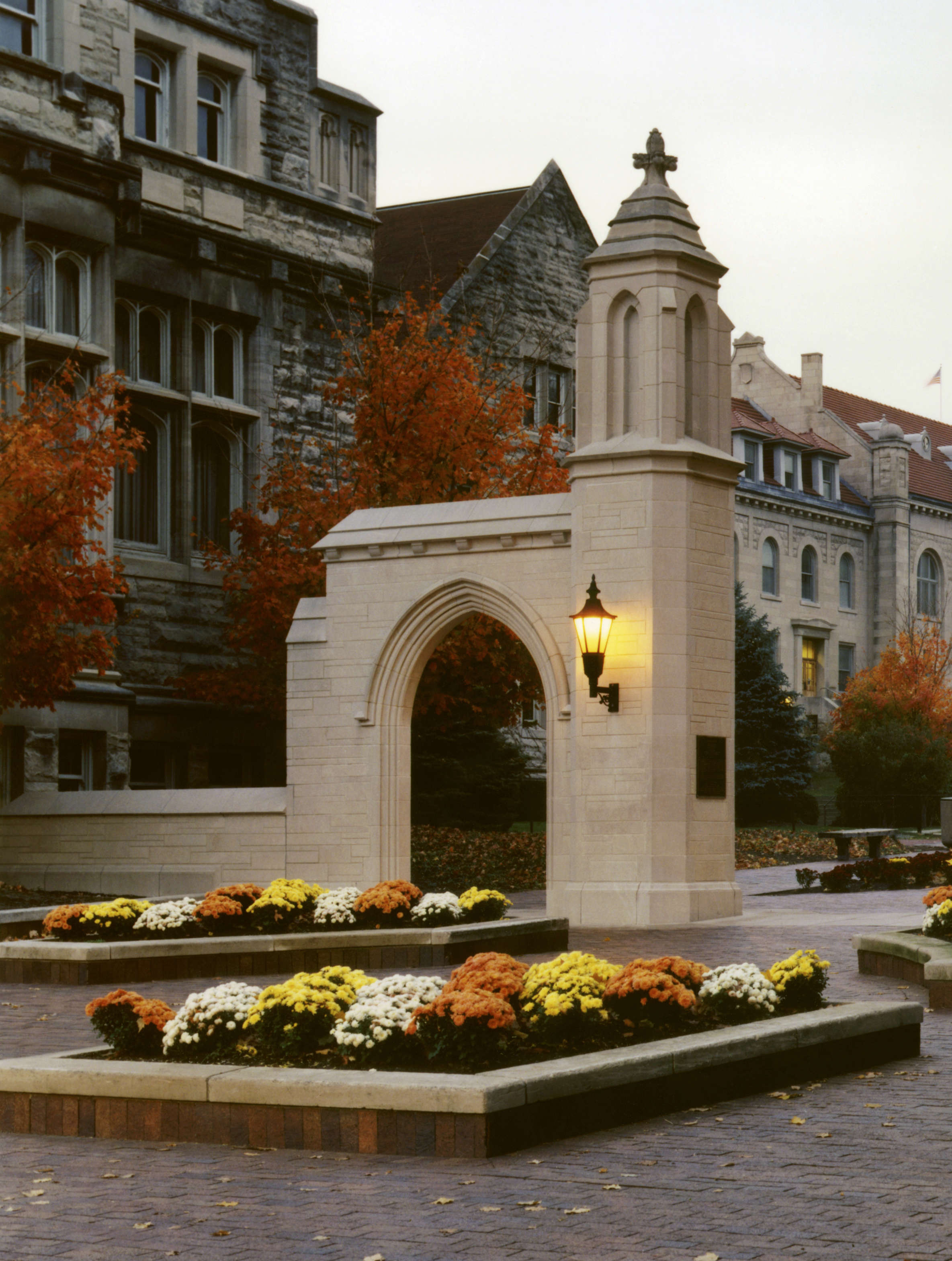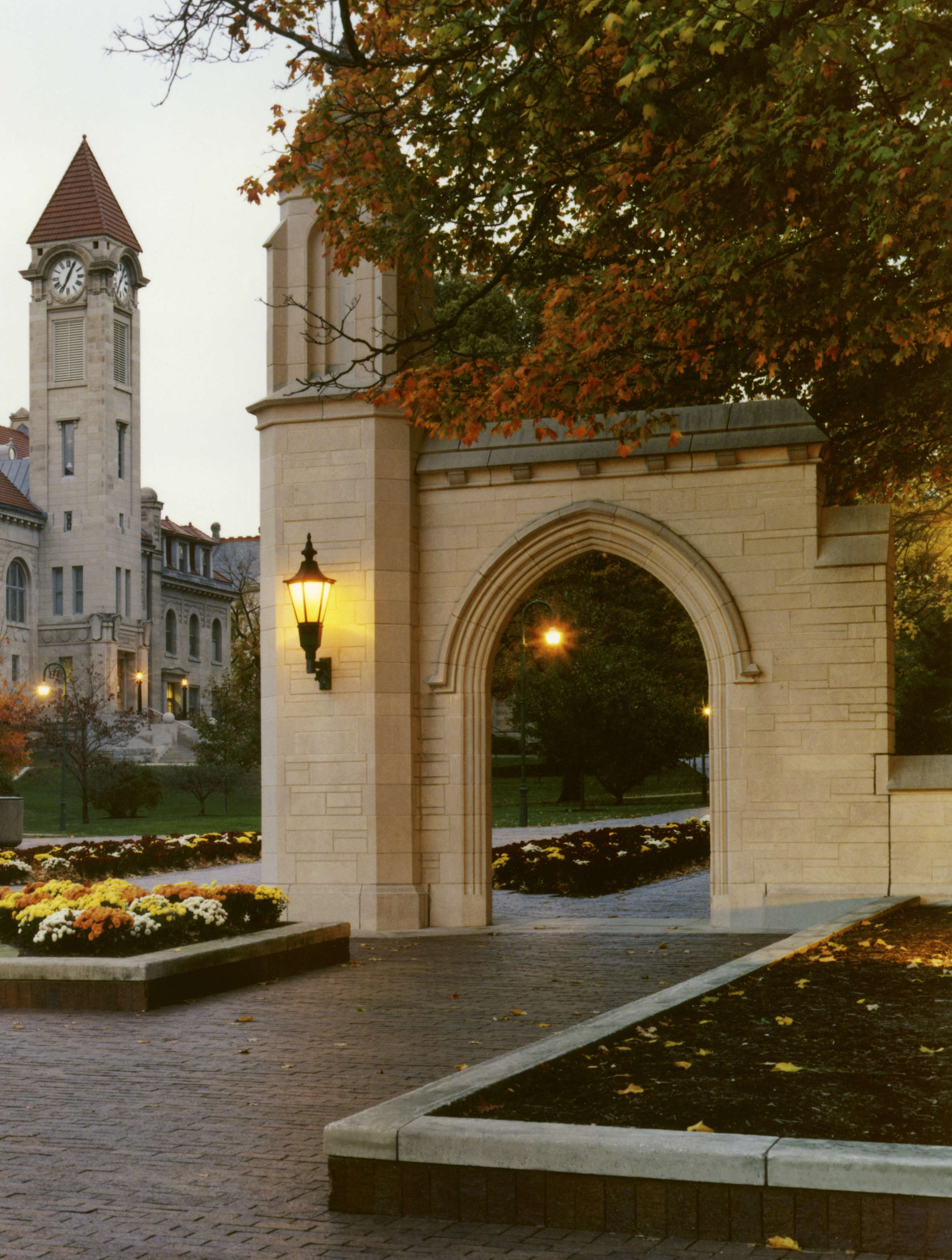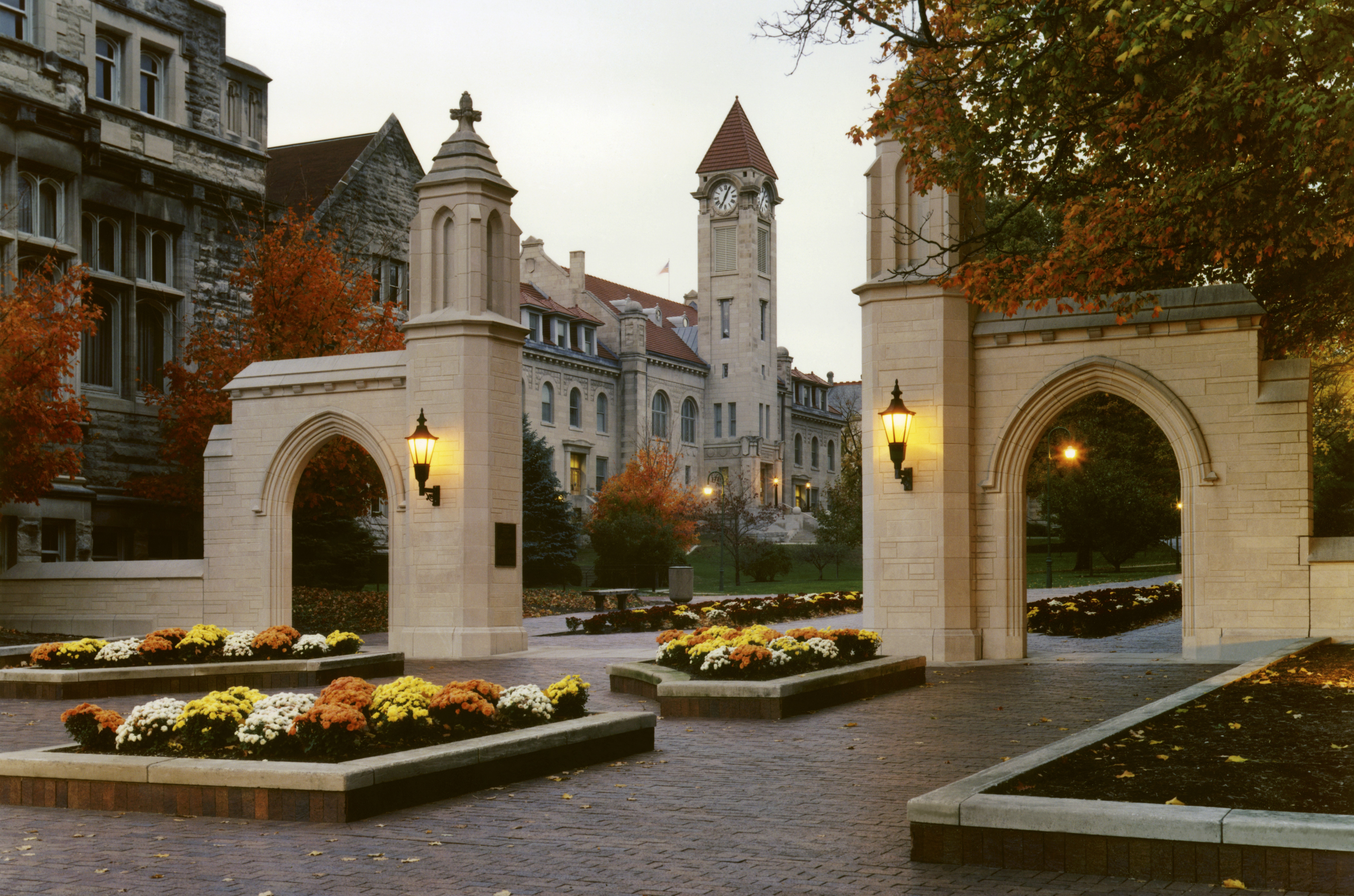
|
Conference Speakers:
|

|

| Poster | Click here to see the conference poster. |
|---|---|
| Support | Full support will be provided for a limited number of graduate students. Additional support may be available for young researchers. To apply for support, please send email to co-organizer Russell Lyons at rdlyons@indiana.edu and also have a brief letter of recommendation sent there as well. Materials are due by March 15, 2015. We will notify applicants of financial support by March 20, 2015. Late applications will be considered as long as money is still available. |
| Banquet | There is no registration fee nor need to register except for the banquet at Samira Afghan Restaurant Friday, May 15, 2015 at 6:30pm. If you are interested in the banquet, which will cost $25, send email to co-organizer Michael Damron at mdamron@indiana.edu by April 17, 2015. There will be many choices of food, including vegetarian. The cost is covered for supported participants. |
| Hotel | We will provide hotel rooms for all supported participants. There is a block of rooms reserved at the Courtyard Marriott Hotel, where the speakers and supported grad students will stay. There are not many rooms there, but there will be some available to others. When you call, tell them you are with the IU Math Dept./Seymour Sherman Conference and ask for group code SSW. If you don't get a room there, see here for a list of hotels. |
| Local registration | On Friday, talks will be held in Swain West 007, while on Saturday and Sunday, they will be in Swain East 140. Registration and breaks will be in the Rawles Hall lounge. These buildings are next to each other. "Registration" means picking up a name badge, talk schedule, restaurant information, and computer information. For supported participants, it also means picking up paperwork for reimbursement of expenses. |
| Travel | For travel information, go here. |
| Photos | For a photo album of campus, go here. Use the slide show available under the arrow menu on the right, and go full screen. |
| Food | For restaurant recommendations, go here. |
Registration and refreshments are in Rawles Hall.
| Friday, May 15 | Saturday, May 16 | Sunday, May 17 |
|---|---|---|
| Swain West 007 | Swain East 140 | Swain East 140 |
| 9:00 coffee, OJ, muffins, bagels | 9:00 coffee, OJ, muffins, bagels | |
| 10:00 registration and coffee | 9:30 Xin Sun: Almost sure multifractal spectrum of SLE 15 years ago B. Duplantier predicted the multifractal spectrum of Schramm Loewner Evolution (SLE), which encodes the fine structure of the harmonic measure of SLE curves. In this talk, I will report our recent rigorous derivation of this prediction. As a byproduct, we also confirm a conjecture of Beliaev and Smirnov for the a.s. bulk integral means spectrum of SLE. The proof uses various couplings of SLE and Gaussian free field, which are developed in the theory of imaginary geometry and Liouville quantum gravity. This is a joint work with E. Gwynne and J. Miller from MIT. | 9:30 Elliot Paquette: The Poisson Voronoi tessellation in hyperbolic space
We consider the hyperbolic Poisson Voronoi (HPV) tessellation, a
tiling of hyperbolic space whose vertices are given by a
homogeneous Poisson point process. These tilings are not
quasi-isometric to hyperbolic space, as arbitrarily large tiles and
arbitrarily small tiles may appear. Nevertheless, we show that
they have have "anchored expansion," a relaxation of
non-amenability. Due to symmetries of hyperbolic space,
the dual graph of HPV is an example of a unimodular random graph.
This, together with anchored expansion, allows us to conclude
many properties of HPV, such as its having positive speed and an
infinite dimensional Poisson boundary.
This is based on joint works with Itai Benjamini, Yoav Krauz, and Josh Pfeffer. |
| 10:30 Philippe Sosoe: On the chemical distance in critical percolation
In two-dimensional critical percolation, the work of
Aizenman-Burchard implies that macroscopic distances inside percolation
clusters are bounded below by a power of the Euclidean distance greater than
$1+\epsilon$, for some positive $\epsilon$. No more precise lower bound has been given so far.
Conditioned on the existence of an open crossing of a box of side length $n$,
there is a distinguished open path which can be characterized in terms of
arm exponents: the lowest open path crossing the box. This clearly gives an
upper bound for the shortest path. The lowest crossing was shown by
Morrow and Zhang to have volume $n^{4/3}+o(1)$ on the triangular lattice.
In 1992, Kesten and Zhang asked how, given the existence of an open crossing, the length of the shortest open crossing compares to that of the lowest; in particular, whether the ratio of these lengths tends to zero in probability. We answer this question positively. Joint work with Michael Damron and Jack Hanson. |
10:45 Balázs Ráth: Percolation on the stationary distributions of the voter model The voter model on $\Z^d$ is a particle system that serves as a rough model for changes of opinions among social agents or, alternatively, competition between biological species occupying space. When $d \ge 3$, the set of (extremal) stationary distributions is a family of measures $\mu_\alpha$, for $\alpha$ between 0 and 1. A configuration sampled from $\mu_\alpha$ is a strongly correlated field of 0's and 1's on $\Z^d$ in which the density of 1's is $\alpha$. We consider such a configuration as a site percolation model on $\Z^d$. We prove that if $d \ge 5$, the probability of existence of an infinite percolation cluster of 1's exhibits a phase transition in $\alpha$. If the voter model is allowed to have sufficiently spread-out interactions, we prove the same result for $d \ge 3$. Joint work with Daniel Valesin (University of Groningen). | 10:45 Lionel Levine: Threshold state of the abelian sandpile A sandpile on a graph is an integer-valued function on the vertices. It evolves according to local moves called topplings. Some sandpiles stabilize after a finite number of topplings, while others topple forever. For any sandpile $s_0$ if we repeatedly add a grain of sand at an independent random vertex, we eventually reach a ``threshold state'' $s_\tau$ that topples forever. Poghosyan, Poghosyan, Priezzhev and Ruelle conjectured a precise value for the expected amount of sand in $s_\tau$ in the limit as $s_0 \to -\infty$. I will outline the proof of this conjecture in http://arxiv.org/abs/1402.3283 and explain how it fits into a larger program aimed at understanding ``system-spanning avalanches''. |
| 1:30 Nike Sun: The exact k-SAT threshold for large k We establish the random $k$-SAT threshold conjecture for all $k$ exceeding an absolute constant $k_0$. That is, there is a single critical value $\alpha_*(k)$ such that a random $k$-SAT formula at clause-to-variable ratio $\alpha$ is with high probability satisfiable for $\alpha \lt \alpha_*(k)$, and unsatisfiable for $\alpha \gt \alpha_*(k)$. The threshold $\alpha_*(k)$ matches the explicit prediction derived by statistical physicists on the basis of the one-step replica symmetry breaking (1RSB) heuristic. In the talk I will describe the main obstacles in computing the threshold, and explain how they are overcome in our proof. Joint work with Jian Ding and Allan Sly. | 1:30 Augusto Teixeira: Percolation and local isoperimetric inequalities In this talk we will discuss some relations between percolation on a given graph $G$ and its geometry. There are several interesting questions relating various properties of $G$, such as growth or dimension, and the process of percolation on $G$. In particular one could look for conditions under which its critical percolation threshold $p_c(G)$ is non-trivial, that is: $p_c(G)$ is strictly between zero and one. In a very influential paper on this subject, Benjamini and Schramm asked whether it was true that for every graph satisfying $\dim(G) \gt 1$, one has $p_c(G) \lt 1$. We will explain this question in detail, explaining what they meant by the dimension of a graph and we will present some results that have been recently obtained in this direction. | 1:00 Toby Johnson: The frog model on trees
Imagine that every vertex of a graph contains a sleeping frog. At time 0,
the frog at some designated vertex wakes up and begins a simple random
walk. When it lands on a vertex, the sleeping frog there wakes up and
begins its own simple random walk, which in turn wakes up any sleeping
frogs it lands on, and so on. This process is called the frog model.
I'll (mostly) answer a question posed by Serguei Popov in 2003: On an infinite $d$-ary tree, is the frog model recurrent or transient? That is, is each vertex visited infinitely or finitely often by frogs? The answer is that it depends on $d$: there's a phase transition between recurrence and transience as $d$ grows. Furthermore, if the system starts with $\mathrm{Poi}(m)$ sleeping frogs on each vertex independently, for any $d\geq 2$ there's a phase transition as $m$ grows. This is joint work with Christopher Hoffman and Matthew Junge. |
| 2:30 Jian Ding: Random geometry of log-correlated Gaussian field In this talk, I will present some recent progress on the random geometry of log-correlated Gaussian field, ranging from the behavior of the extreme values to some metric properties of random surfaces given by the exponential of the Gaussian field. | 2:30 Eviatar Procaccia: Continuity of the time and isoperimetric constants on supercritical percolation In this talk two different results with a single proof will be discussed. One is the continuity of the time constant of first passage percolation with respect to the law of the passage times (with possibly infinite passage times). The other is continuity of the isoperimetric constant of super critical percolation with respect to the percolation parameter. The connection is made through a representation of the isoperimetric constant as a solution of a variational problem with respect to a specific norm. | 2:00 Alexander Fribergh: The ant in *a* labyrinth One of the most famous open problem in random walks in random environments is to understand the behavior of a simple random walk on a critical percolation cluster, a model known as "the ant in the labyrinth". I will present new results on the scaling limit for the simple random walk on the critical branching random walk in high dimension. In the light of lace expansion, we believe that the limiting behavior of this model should be universal for simple random walks on critical structures in high dimensions. This is a joint work with G. Ben Arous and M. Cabezas. |
| 3:30 tea | 3:30 coffee, fruit, nuts | 3:00 coffee, fruit, nuts |
| 4:00 Andrea Montanari (Sherman Lecture): Spin models, Random graphs, and Semidefinite relaxations Statistical mechanics ideas have proven extremely useful in attacking key problems in random graphs and probabilistic combinatorics. I will discuss how statistical mechanics ideas can shed light on the properties of extremal cuts of large random graphs. From an algorithmic point of view, semidefinite relaxations are powerful tool to compute such cuts. Somewhat surprisingly, statistical mechanics ideas can also be used to understand the success of these relaxations. [Based on joint work with Amir Dembo and Subhabrata Sen.] | 4:00 Paul Bourgade: From the mesoscopic to microscopic scale in random matrix theory Eugene Wigner has envisioned that the distributions of the eigenvalues of large Gaussian random matrices are new paradigms for universal statistics of large correlated quantum systems. These random matrix eigenvalues statistics supposedly occur together with delocalized eigenstates. In this lecture, I will explain recent developments proving this paradigm, for both eigenvalues and eigenvectors of random matrices. This is achieved by bootstrap on scales, from mesoscopic to microscopic. Random walks in random environments, homogenization and the coupling method play a key role. | 3:30 Alex Zhai: Exponential concentration of cover times
For random walk on a graph, the cover time is the time it takes for all
the vertices to be visited at least once. Ding, Lee, and Peres (2010) proved
a connection between the cover time and the Gaussian free field. The
connection is obtained via a miraculous formula known as the generalized
second Ray-Knight theorem, which remains somewhat mysterious despite
many years of study.
We will prove a stochastic domination in the generalized second Ray- Knight theorem, which was observed by Ding (2011) to imply that the cover time is exponentially concentrated around its expectation. It was later pointed out to us that this stochastic domination result appeared earlier in a preprint of Lupu, but the connection to cover times was not mentioned. We do not assume familiarity with Gaussian free fields and Ray-Knight theorems. |
| 6:30 banquet at Samira's | 5:15 Vadim Gorin: Central Limit Theorem for discrete log-gases
A log-gas is an ensemble of $N$ particles on the real line, for which the
probability of a configuration is the power of the Vandermonde determinant
times the product of a weight $w(x)$ over the positions of particles. Such
ensembles are widespread in the random matrix theory, while their discrete
counterparts appear in numerous statistical mechanics models such as random
tilings and last passage percolation.
I will explain a new approach which gives Central Limit Theorems for global fluctuations of discrete log-gases for a wide class of the weights $w(x)$. The approach is based on novel discrete equations, which are analogues of the loop equations known in the continuous settings. |
I will explain a new approach which gives Central Limit Theorems for global fluctuations of discrete log-gases for a wide class of the weights $w(x)$. The approach is based on novel discrete equations, which are analogues of the loop equations known in the continuous settings.
I'll (mostly) answer a question posed by Serguei Popov in 2003: On an infinite $d$-ary tree, is the frog model recurrent or transient? That is, is each vertex visited infinitely or finitely often by frogs? The answer is that it depends on $d$: there's a phase transition between recurrence and transience as $d$ grows. Furthermore, if the system starts with $\mathrm{Poi}(m)$ sleeping frogs on each vertex independently, for any $d\geq 2$ there's a phase transition as $m$ grows. This is joint work with Christopher Hoffman and Matthew Junge.
This is based on joint works with Itai Benjamini, Yoav Krauz, and Josh Pfeffer.
In 1992, Kesten and Zhang asked how, given the existence of an open crossing, the length of the shortest open crossing compares to that of the lowest; in particular, whether the ratio of these lengths tends to zero in probability. We answer this question positively.
Joint work with Michael Damron and Jack Hanson.
Links: Talk
Links: Paper
Links: Paper
Links: Paper
We will prove a stochastic domination in the generalized second Ray- Knight theorem, which was observed by Ding (2011) to imply that the cover time is exponentially concentrated around its expectation. It was later pointed out to us that this stochastic domination result appeared earlier in a preprint of Lupu, but the connection to cover times was not mentioned. We do not assume familiarity with Gaussian free fields and Ray-Knight theorems.


